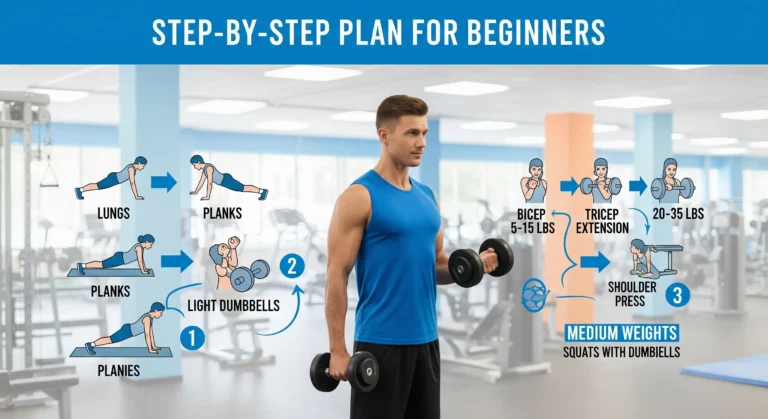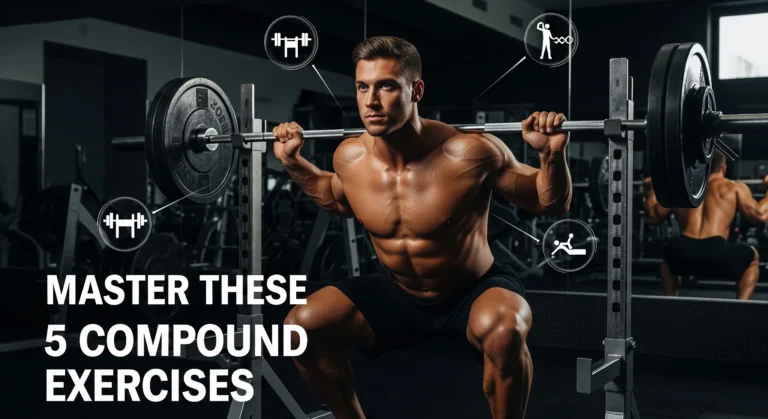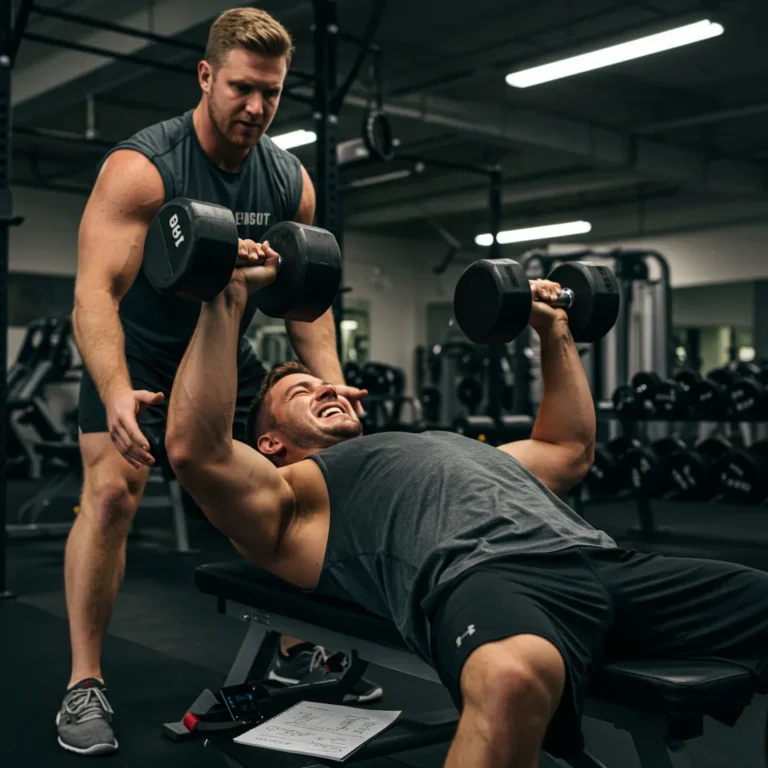
Did you know that despite decades of research, scientists are still debating what actually causes our muscles to grow? I remember when I first started lifting seriously – I was obsessed with getting that “muscle burn” and soreness after every workout, thinking it was the golden ticket to gains. Boy, was I wrong about some things!
The biggest question in muscle building today is whether mechanical tension or muscle damage is more important for hypertrophy. The hypertrophy puzzle has three main pieces: mechanical tension, metabolic stress, and muscle damage. But here’s where it gets interesting – recent research is flipping our understanding upside down. While we used to think muscle damage was crucial for growth, new evidence suggests mechanical tension might be the real MVP. So what’s the truth about mechanical tension or muscle damage? Let’s dive into the science and figure out what actually drives muscle hypertrophy!
Understanding the Three Mechanisms of Hypertrophy
When I first learned about hypertrophy mechanisms, I thought it was pretty straightforward. You lift heavy things, your muscles get damaged, they repair bigger and stronger. Simple, right?
Wrong! It’s way more complex than that.
The three main mechanisms that researchers believe contribute to muscle hypertrophy are mechanical tension, metabolic stress, and muscle damage. Think of them as three different pathways your body uses to signal “hey, we need bigger muscles here!”
Mechanical tension happens when your muscle fibers are under load – essentially the force your muscles generate when they contract against resistance. This is what you feel when you’re grinding out that last rep of a heavy squat. Your muscle fibers are firing hard, creating tension throughout the entire muscle.
Metabolic stress is that burning sensation you get during high-rep sets. It’s the accumulation of metabolites like lactate, hydrogen ions, and inorganic phosphate in your muscles. You know that pump you get after doing 20 reps of bicep curls? That’s metabolic stress in action.
Muscle damage is exactly what it sounds like – microscopic damage to your muscle fibers that occurs during training. This isn’t necessarily the soreness you feel (though they’re related), but actual structural damage at the cellular level.
For years, the fitness industry ran with this “three mechanisms” model like it was gospel. Every workout program seemed designed to maximize all three. But here’s where things get interesting – recent research is showing that these mechanisms aren’t equally important for muscle growth.
Mechanical Tension: The Primary Driver of Muscle Growth
I’ll be honest – it took me way too long to truly understand what mechanical tension meant beyond just “lifting heavy weights.” But once I got it, everything clicked into place about why some of my training strategies worked better than others.
Mechanical tension isn’t just about the weight on the bar. It’s about how much force your muscle fibers are generating, regardless of the load. This is why you can build muscle with lighter weights if you take sets close to failure – your muscles are still generating high levels of tension even with less external load.
Think about it this way: when you’re doing the last few reps of any set taken to near-failure, your muscle fibers are working their butts off. They’re recruiting more and more motor units to keep moving that weight. This recruitment and the resulting tension is what appears to be the primary signal for muscle growth.
The research backing this up is pretty compelling. Studies comparing high-load training (heavy weights, low reps) with low-load training (lighter weights, high reps) consistently show similar hypertrophy when both groups train to similar levels of effort. The key factor? Both groups were creating high levels of mechanical tension, just through different means.
Dr. Brad Schoenfeld’s research has been particularly eye-opening here. His work suggests that as long as you’re creating sufficient mechanical tension – typically by training within a few reps of failure – the specific load becomes less important for hypertrophy.
This was a game-changer for my own training. Instead of always chasing heavier weights, I started focusing on making sure every set was challenging throughout the entire rep range. Sometimes that meant going heavier, sometimes it meant slowing down the tempo or improving my form.
The practical implication? You don’t need to train exclusively in the 1-5 rep range to maximize muscle growth. Mechanical tension can be achieved across a wide range of rep ranges, as long as you’re pushing your muscles hard enough.
Muscle Damage: Necessary Evil or Overrated Factor?
Here’s where I have to eat some humble pie. For years, I chased muscle damage like it was the secret sauce for gains. If I wasn’t hobbling around sore for days after a workout, I figured I didn’t train hard enough.
Man, was I missing the point.
Muscle damage and the soreness that often comes with it (DOMS – delayed onset muscle soreness) are not the same thing as effective muscle building. In fact, excessive muscle damage might actually hinder your progress by requiring more recovery time and potentially interfering with your ability to train frequently.
The research on muscle damage and hypertrophy is fascinating and honestly pretty surprising. While some degree of muscle damage is probably inevitable during resistance training, it doesn’t appear to be a primary driver of muscle growth. Studies have shown that you can build muscle effectively without significant muscle damage, and conversely, high levels of muscle damage don’t necessarily correlate with better hypertrophy.
I learned this the hard way during a phase where I was doing way too many eccentric-focused workouts. You know, those super slow negatives that leave you unable to straighten your arms for a week? Yeah, I was destroying my muscles but my gains were actually slower because I couldn’t train consistently.
The key insight here is understanding what muscle damage actually represents. It’s cellular disruption – damaged sarcomeres, compromised membrane integrity, and inflammatory responses. While the repair process might contribute to some muscle growth, it’s not the primary mechanism we once thought it was.
Current research suggests that muscle damage might be more of a byproduct of effective training rather than a requirement for it. When you create high levels of mechanical tension, some muscle damage will occur naturally, but chasing damage for its own sake is missing the forest for the trees.
This doesn’t mean you should completely avoid exercises or techniques that cause muscle damage. Eccentric training, for example, can be valuable for strength and hypertrophy. But the focus should be on the mechanical tension created, not the damage caused.
The Truth About Soreness and Muscle Building
Let me tell you about one of the biggest mistakes I made early in my lifting career. I used to rate my workouts based on how sore I was the next day. No soreness? Must not have worked hard enough. Couldn’t walk up stairs? Perfect workout!
This mindset is not only wrong, it’s counterproductive.
Soreness is a terrible indicator of workout effectiveness for muscle building. I’ve had some of my best hypertrophy phases during periods when I rarely experienced significant soreness. Conversely, some of my worst progress came during times when I was constantly beat up and sore.
The relationship between muscle damage, soreness, and hypertrophy is complicated. DOMS is primarily caused by eccentric muscle damage and the resulting inflammatory response. But this inflammatory response doesn’t necessarily translate to better muscle growth – in fact, it might impede it by interfering with muscle protein synthesis and requiring energy that could otherwise be used for adaptation.
Here’s what I’ve learned through trial and error (and lots of research): soreness tells you that you did something your muscles weren’t adapted to, not necessarily that you stimulated growth. When you start a new program, change exercises, or dramatically increase volume, you’ll likely get sore. But as your muscles adapt, soreness decreases even if the growth stimulus remains high.
I remember when I switched from primarily machine-based training to free weights. I was sore everywhere for weeks, but it wasn’t because the free weights were creating better hypertrophy – it was because my stabilizing muscles and movement patterns weren’t adapted to the new demands.
The “no pain, no gain” mentality has done a disservice to a lot of lifters. Pain (in the form of excessive soreness or actual injury) often indicates that recovery is compromised, which is the opposite of what you want for optimal muscle growth.
So how should you interpret post-workout soreness? Use it as information about your recovery status and training adaptation. Mild soreness a day or two after training? Probably fine. Severe soreness that impacts your daily activities or ability to train? That’s a sign to pull back and focus on recovery.
Practical Training Applications: Optimizing for Hypertrophy
Alright, let’s get into the practical stuff – how do you actually apply this knowledge to build more muscle? This is where the rubber meets the road, and honestly, where I wish I had better guidance when I was starting out.
First and foremost, your training should prioritize creating high levels of mechanical tension. This doesn’t mean you need to load the bar with maximum weight every session. Instead, focus on making your muscles work hard throughout challenging rep ranges.
One of the biggest changes I made to my training was paying more attention to proximity to failure. Instead of stopping at some arbitrary rep count, I started pushing sets to within 1-3 reps of failure consistently. This ensures that mechanical tension stays high throughout the set as your muscles recruit more motor units to maintain force output.
Rep ranges matter less than I used to think, but they’re not irrelevant. Research shows you can build muscle effectively anywhere from about 5-30 reps per set, as long as you’re training hard enough. I typically program most of my hypertrophy work in the 6-15 rep range because it offers a good balance of mechanical tension and training efficiency.
Time under tension has become another tool in my arsenal, but not in the way most people think about it. Rather than artificially slowing down every rep, I focus on controlling the weight through a full range of motion. This naturally increases time under tension while maintaining the ability to create high levels of mechanical tension.
Here’s a practical example: instead of doing bicep curls with momentum and partial range of motion, I’ll use a slightly lighter weight and focus on a full stretch at the bottom, controlled concentric, and brief pause at the top. Same exercise, but much more effective for hypertrophy.
Exercise selection has also evolved in my programming. While compound movements like squats, deadlifts, and presses remain the foundation, I’ve learned to appreciate isolation exercises for their ability to create high levels of mechanical tension in specific muscles without systemic fatigue.
Volume management is crucial too. More isn’t always better if it comes at the expense of training intensity or recovery. I’ve found that doing fewer sets taken closer to failure is more effective than doing many sets with reps left in the tank.
Programming Strategies Based on Hypertrophy Mechanisms
Let me share some programming strategies I’ve developed over the years based on what we know about hypertrophy mechanisms. These aren’t rigid rules, but principles that have consistently worked for me and the people I’ve helped with their training.
Periodization for hypertrophy looks different when you understand that mechanical tension is the primary driver. Instead of constantly chasing heavier weights or more volume, I focus on maintaining high levels of effort across training blocks while managing fatigue.
My favorite approach is what I call “effort-based periodization.” Rather than programming specific percentages of 1RM, I program based on RPE (Rate of Perceived Exertion) or RIR (Reps in Reserve). This ensures that mechanical tension stays high regardless of daily fluctuations in strength or energy levels.
For example, instead of prescribing “3 sets of 8 at 75% 1RM,” I might program “3 sets of 6-10 reps at RPE 8-9.” This allows for auto-regulation while ensuring the primary hypertrophy stimulus (mechanical tension) remains consistent.
Frequency is another area where understanding hypertrophy mechanisms has changed my approach. Since muscle protein synthesis appears to return to baseline within 48-72 hours after training, hitting each muscle group 2-3 times per week makes more sense than once-weekly body part splits for most people.
I typically structure training around movement patterns rather than body parts, which naturally allows for higher frequency while managing fatigue. A push/pull/legs split performed twice weekly hits everything with good frequency while allowing adequate recovery.
Recovery monitoring has become much more sophisticated in my programming. Instead of relying on soreness as an indicator, I pay attention to performance metrics, sleep quality, and subjective measures of readiness. If you can maintain or improve performance on key exercises, you’re probably recovering adequately regardless of how sore you are.
One strategy I’ve found particularly effective is using “activation” exercises early in workouts. These are typically isolation movements performed for moderate reps (10-15) to get target muscles firing before compound movements. This helps ensure that the intended muscles are contributing maximally to the mechanical tension created during heavier compound lifts.
Training to failure is a topic that deserves special attention. While you don’t need to train to failure on every set, occasionally pushing to true muscular failure can be valuable for ensuring you’re creating maximal mechanical tension and for learning what true effort feels like.
Conclusion
The hypertrophy debate isn’t just academic mumbo-jumbo – it has real implications for how we train! After diving deep into the research, it’s clear that mechanical tension deserves the spotlight as the primary driver of muscle growth. This doesn’t mean muscle damage is completely useless, but it’s definitely not the growth catalyst we once thought it was.
Here’s the bottom line: focus on creating high levels of mechanical tension through progressive overload, challenging rep ranges, and proper form. Don’t chase soreness or try to destroy your muscles in every session. Instead, think about stimulating growth consistently while allowing adequate recovery. Your muscles will thank you with better gains and fewer setbacks!
The practical implications are huge. You can build muscle effectively across a wide range of rep ranges, you don’t need to be sore to know you had a good workout, and consistency trumps intensity when it comes to long-term progress.
Ready to revolutionize your training approach? Start by tracking your progression in terms of load, reps, and proximity to failure rather than how sore you feel the next day. Focus on creating mechanical tension through challenging sets taken close to failure, and don’t worry if you’re not limping out of the gym.
Share your experiences with these concepts in the comments – I’d love to hear how shifting your focus to mechanical tension impacts your results! Remember, the best training program is the one you can stick to consistently while progressively challenging your muscles over time.



